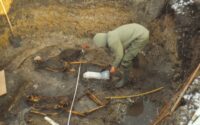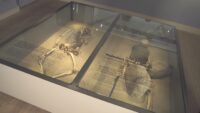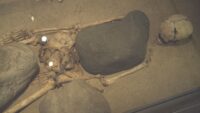 DNA has solved one mystery of an enigmatic Viking double burial now in the Roskilde Museum. The 9th century grave was discovered in 1981 in the village of Gerdrup just north of Roskilde, Denmark. Inside were the skeletal remains of a man and woman. They were treated very differently, both in the quantity, quality and significance of the grave goods and in the ways their bodies were put to rest.
DNA has solved one mystery of an enigmatic Viking double burial now in the Roskilde Museum. The 9th century grave was discovered in 1981 in the village of Gerdrup just north of Roskilde, Denmark. Inside were the skeletal remains of a man and woman. They were treated very differently, both in the quantity, quality and significance of the grave goods and in the ways their bodies were put to rest.
The woman was middle aged when she died. Osteological examination of her pelvic bone found evidence that she had given birth during her lifetime. She was found with an iron knife by her side where he belt would have been and a needle case made of bone. Next to her right leg was an iron spearhead more than 14 inches long. Her body was weighted down by large stones. This was the first find where it was conclusively determined that a Viking woman was buried with a weapon.
 The man was bout 35-40 years old at time of death. His knees are bent outwards and ankles crossed in a sort of frogman posture that suggests the ankles were probably tied together when he was buried. His head is inclined in a twisted position; his neck was broken, likely by hanging. Buried at his side was a heavily worn iron knife.
The man was bout 35-40 years old at time of death. His knees are bent outwards and ankles crossed in a sort of frogman posture that suggests the ankles were probably tied together when he was buried. His head is inclined in a twisted position; his neck was broken, likely by hanging. Buried at his side was a heavily worn iron knife.
The woman must have been someone of great importance in her community to be buried with a lance. It is incongruous that someone of high status would be buried next to a man who appeared to have been hanged and tied up before burial. Archaeologists have hypothesized that she was given a spear as a symbol of Odin who was often depicted with his Dwarf-crafted spear Gungnir. The hanged man by her side could have been a slave who was sacrificed to serve her in death.
Archaeological DNA has discovered that in fact the woman and man were mother and son. This explains why they were buried together, if not the circumstances of their life and diverging manners death. One intriguing possibility is that this was a kernel-of-truth version of a story in one of the Icelandic sagas, that the “spearhead” was in fact the wand of a sorceress who was stoned to death and her son hanged.
Written in the mid-13th century, the Eyrbyggja Saga is an anthology of legends. Two of the chapters tell the tale of Katla and her son Odd, and it’s an entertaining rollercoaster ride of cool names and weirdness, so I’m going to summarize it at length, tldr be damned.
It all started one autumn with an act of horse thievery. Thorbiorn the Thick’s herd of horses had disappeared without a trace, so he sent Odd Katlason to one Cunning-Gils, a soothsayer who was known for his skill at uncovering thefts and other crimes. Cunning-Gils told Odd that the horses were not far from the home pastures, but wouldn’t name names. Thorbiorn and Odd blamed one of his neighbors, Thorarin, who was poor but who recently had acquired a passel of new servants.
Thorbiorn assembled a posse and demanded to ransack Thorarin’s house. Thorarin declined, counter-demanding that a court determine the veracity of the charge before allowing a legal ransacking. A court of six men were assembled and Thorbiorn presented his case. Thorarin’s mom Geirrid called her son a coward if he took this, so he busted up the court and a violent encounter between the parties ensued.
Here’s where it gets weird. After the bloody fight, Thorarin found a severed hand on the field and recognized it as that of his wife Aud. Mad as badger, Thorarin set out to discover which of Thorbiorn’s men had done the wicked deed. He caught up with the party and overheard Odd Katlason bragging about having done it. Thorarin attacked them and slaughtered almost everyone. Three men got away. Odd was one of them. He wasn’t even wounded, as every blow simply glanced off the brown kirtle his mother Katla had given him.
When Thorarin’s men, led by Arnkel, went to Katla’s house looking for Odd, she masked him with her magic. To them, she seemed to be placidly spinning yarn on her distaff. As they rode off, they began to wonder if she had bewitched them into thinking Odd was a distaff. They returned again, and found the distaff on the bench. Katla was outside coming and playing with a goat. The men searched the house and left empty-handed. This time they grew suspicious that the goat may have been Odd, so, they returned again, searched again and again found nothing but Katla’s hog lying next to the rubbish heap. Yup, that hog was Odd.
This time the disappointed party was met by the formidable Geirrid who insisted on returning with them to deal with Katla herself. Katla knew her spells, while good enough to fool Thorarin’s goons, would be useless against a witch as strong as Geirrid. She hid Odd in a secret compartment under her floor this time.
 Geirrid strode in, covered Katla’s head with a sealskin bag and tied it around her neck. She had the men break through the floor where they found Odd. They tied him up and transported both him and his mother to Buland Head where Odd was hanged. As Odd kicked and flailed his last, Arnkel told him it was his evil mother’s fault that he was dying like this. Katla responded that she was the who had started this whole bloody mess by disappearing Thorbiornson’s horses and then cursed Arnkel that he would get worse from being his father’s son than Odd ever had gotten from being her son. They promptly stoned her to death.
Geirrid strode in, covered Katla’s head with a sealskin bag and tied it around her neck. She had the men break through the floor where they found Odd. They tied him up and transported both him and his mother to Buland Head where Odd was hanged. As Odd kicked and flailed his last, Arnkel told him it was his evil mother’s fault that he was dying like this. Katla responded that she was the who had started this whole bloody mess by disappearing Thorbiornson’s horses and then cursed Arnkel that he would get worse from being his father’s son than Odd ever had gotten from being her son. They promptly stoned her to death.
So a hanged son and a stoned mother. Well… Kinda… The woman in the Gerdrup grave was pinned under large stones after death, not stoned or pressed or in any other way killed by rocks. Beyond the imagery of it, the link between the burial and the saga is more nonexistent than tenuous based on current information, but it’s still neat enough to get an honorable mention.
…Keeping Up with the Uexküll’s :skull:
It’s pretty obvious that only someone with other-worldly powers would need to be weighed down quite so emphatically.
I love that story and think it’s all true. 👿
If it’s not true, it should be.
What a wonderful story! Many thanks for this and all your other great articles on this blog.
If that’s the stone she was under, then likely “stoned” meant “pressed to death under stones” as I’ve read was sometimes done with criminals.
…sounds like Stevenage!
“…as every blow simply glanced off the brown kirtle”
Ah, you mean that old set of rusty chainmail!
It is interesting that the story specifically mentions the colour of that particular item of clothing, as the sole commentary on fashion.
Thorbiorn the Thick???
God but I love Viking names! This one’s almost as good as Ulf the Unwashed!